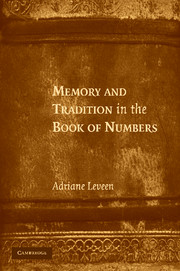Book contents
- Frontmatter
- Contents
- Acknowledgments
- ONE Desert Bound
- TWO Weaving by Design
- THREE Priestly Purposes
- FOUR Variations on a Theme: Shaping Memory in the Wilderness
- FIVE Crisis and Commemoration: The Use of Ritual Objects
- SIX Falling in the Wilderness: The Politics of Death and Burial
- SEVEN Inheriting the Land
- APPENDIX A The Priestly Sphere of Activity in the Book of Numbers
- APPENDIX B The Use and Variation of God's Address to Moses and to Aaron
- APPENDIX C Death Reports
- APPENDIX D Proper and Improper Treatment of the Dead
- Notes
- Bibliography
- Index
- Scriptural Index
- Selected Hebrew Index
FIVE - Crisis and Commemoration: The Use of Ritual Objects
Published online by Cambridge University Press: 21 July 2009
- Frontmatter
- Contents
- Acknowledgments
- ONE Desert Bound
- TWO Weaving by Design
- THREE Priestly Purposes
- FOUR Variations on a Theme: Shaping Memory in the Wilderness
- FIVE Crisis and Commemoration: The Use of Ritual Objects
- SIX Falling in the Wilderness: The Politics of Death and Burial
- SEVEN Inheriting the Land
- APPENDIX A The Priestly Sphere of Activity in the Book of Numbers
- APPENDIX B The Use and Variation of God's Address to Moses and to Aaron
- APPENDIX C Death Reports
- APPENDIX D Proper and Improper Treatment of the Dead
- Notes
- Bibliography
- Index
- Scriptural Index
- Selected Hebrew Index
Summary
The ritual construction of authority is a stabilization of power and therein a specific augmentation of power.
In the midst of a discussion looking back at the biblical period when kings ruled Israel, the rabbis of the Talmud raised the following question:
Was, however, the anointing oil in existence [in the days of Jehoahaz]? Surely it was taught: At the time when the Holy Ark was hidden away there were also hidden the anointing oil, the jar of manna, Aaron's staff with its almonds and blossoms, and the coffer which the Philistines had sent to Israel as a gift…. And who hid them? It was Josiah, King of Judah.
(Talmud Bavli: Horayoth 12a)Were they ever found? Indeed, what was the fate of the many objects mentioned in the bible from the period of the First Temple and even earlier? As attested in the rabbis' discussion, the question did not have a clear answer. Speculation and uncertainty surrounded the subsequent history of many objects mentioned in the early texts of Israel. What the rabbis did possess, however, were the biblical stories of their formation. We possess those same stories.
In particular, the story of Aaron's staff, with its almonds and blossoms, is of direct interest to the present discussion as it is the last of three objects that figure in a series of dramatic crises at the core of the Book of Numbers.
- Type
- Chapter
- Information
- Memory and Tradition in the Book of Numbers , pp. 97 - 139Publisher: Cambridge University PressPrint publication year: 2007



